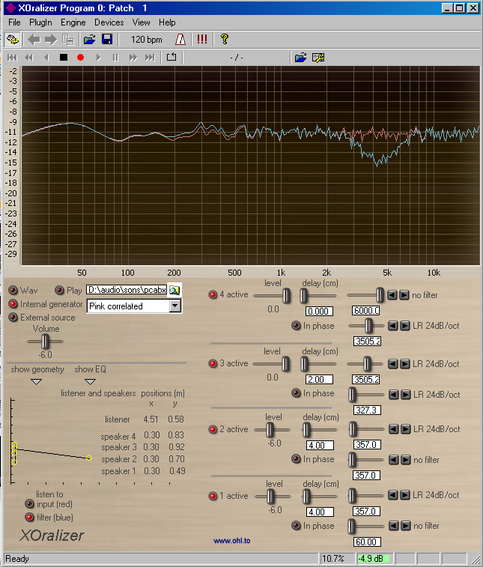Hi,
I remember some time ago reading a webpage that compared different crossover types and also showed their polar response in the vertical domain (in a vertical driver alignment). I can't find it now, does anyone now what it was?
I am thinking of building a MTM design and from memory this webpage showed that, in a MTM, a 3rd order butterworth filter had wider vertical polar response than a 4th order LR.
However I don't think 3rd order will be steep enough for my design idea. Would a 6th order Butterworth have the same effect?
Thanks!
I remember some time ago reading a webpage that compared different crossover types and also showed their polar response in the vertical domain (in a vertical driver alignment). I can't find it now, does anyone now what it was?
I am thinking of building a MTM design and from memory this webpage showed that, in a MTM, a 3rd order butterworth filter had wider vertical polar response than a 4th order LR.
However I don't think 3rd order will be steep enough for my design idea. Would a 6th order Butterworth have the same effect?
Thanks!
Thanks Jl,
That program is nice but it doesn't seem to support 6th order crossovers? Any chance you could quickly add this for me?
It seems looking at the program that despite 4th order LR having sharper filters, the 3rd order butterworth manages less off axis suckout on a MTM design. So can anyone confirm if a 6th order Butterworth has the same advantages? You see I can't really use a 3rd order as it won't protect the drivers enough. So I can use a 4th order LR design, but if a 6th order Butterworth will give less suckout not just because of the sharper filters but also because of the phase interaction then I will go for that. Comments?!
That program is nice but it doesn't seem to support 6th order crossovers? Any chance you could quickly add this for me?
It seems looking at the program that despite 4th order LR having sharper filters, the 3rd order butterworth manages less off axis suckout on a MTM design. So can anyone confirm if a 6th order Butterworth has the same advantages? You see I can't really use a 3rd order as it won't protect the drivers enough. So I can use a 4th order LR design, but if a 6th order Butterworth will give less suckout not just because of the sharper filters but also because of the phase interaction then I will go for that. Comments?!
jlo said:Hi, you can use this (free) software to simulate your driver positions (MTM or others) and crossover types. Then listen to the result in realtime when you move listening position and angle.
Without inputs for wall locations and absorption coefficients it's not going to give a good idea of how the speaker sounds in-room.
The spectrum of early reflections and reverberant field which are a product of the room and polar response have a lot to do with what a speaker sounds like in a domestic environment.
For example, I'd speculate that the broader but shallower power response dip explains the difference most people hear with a first order cross-over versus LR4 given that they can't hear the second order all-pass of a 4th order Linkwitz Riley filter applied by itself.
Tenson said:I am thinking of building a MTM design and from memory this webpage showed that, in a MTM, a 3rd order butterworth filter had wider vertical polar response than a 4th order LR.
However I don't think 3rd order will be steep enough for my design idea. Would a 6th order Butterworth have the same effect
I believe you will find that even order crossovers are symmetric and odd are not. The nonsymmetric nature is what somewhat evens out the polar response of a 3rd order MTM. There are still off axis aberrations in any MTM that are not related to the crossover, and the sharper the crossover, the less lobing problems you have because the bandwidth where the drivers interfere is less. I don't think lobing errors merit going to 6th order.
Re: Re: Crossover Types and Polar Response?
Thanks guys, that is what I needed to know. I will aim for a 5th order Butterworth then.
Ron E said:
I believe you will find that even order crossovers are symmetric and odd are not. The nonsymmetric nature is what somewhat evens out the polar response of a 3rd order MTM. There are still off axis aberrations in any MTM that are not related to the crossover, and the sharper the crossover, the less lobing problems you have because the bandwidth where the drivers interfere is less. I don't think lobing errors merit going to 6th order.
a.wayne said:Odd order is best for MTM layout ...................
Thanks guys, that is what I needed to know. I will aim for a 5th order Butterworth then.
- Status
- This old topic is closed. If you want to reopen this topic, contact a moderator using the "Report Post" button.
- Home
- Loudspeakers
- Multi-Way
- Crossover Types and Polar Response?
